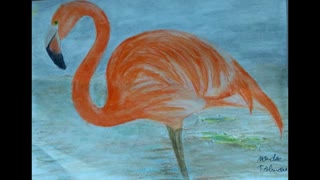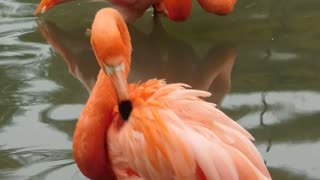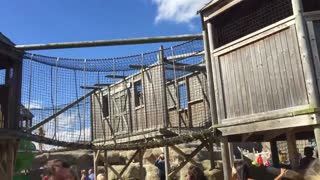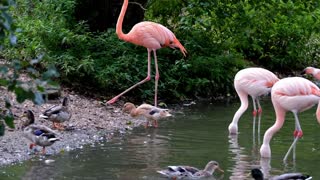Premium Only Content

The Flamingo
The Flamingo are a type of wading bird in the family Phoenicopteridae, the only bird family in the order Phoenicopteriformes. Four flamingo species are distributed throughout the Americas, including the Caribbean, and two species are native to Africa, Asia, and Europe.
The name "flamingo" comes from Portuguese or Spanish flamengo, "flame-colored", in turn coming from Provençal flamenc from flama "flame" and Germanic-like suffix -ing, with a possible influence of the Spanish ethnonym flamenco "Fleming" or "Flemish". The generic name Phoenicopterus (from Greek: φοινικόπτερος phoinikopteros), literally means "blood red-feathered" has a similar etymology to the common name;[3] other genera include Phoeniconaias, which means "crimson/red water nymph (or naiad)", and Phoenicoparrus, which means "crimson/red bird (though, an unknown bird of omen)".
Traditionally, the long-legged Ciconiiformes, probably a paraphyletic assemblage, have been considered the flamingos' closest relatives and the family was included in the order. Usually, the ibises and spoonbills of the Threskiornithidae were considered their closest relatives within this order. Earlier genetic studies, such as those of Charles Sibley and colleagues, also supported this relationship.[4] Relationships to the waterfowl were considered as well,[5] especially as flamingos are parasitized by feather lice of the genus Anaticola, which are otherwise exclusively found on ducks and geese.[6] The peculiar presbyornithids were used to argue for a close relationship between flamingos, waterfowl, and waders.A 2002 paper concluded they are waterfowl,[8] but a 2014 comprehensive study of bird orders found that flamingos and grebes are not waterfowl, but rather are part of Columbea along with doves, sandgrouse, and mesites.
Recent molecular studies have suggested a relation with grebes,[10][11][12] while morphological evidence also strongly supports a relationship between flamingos and grebes. They hold at least 11 morphological traits in common, which are not found in other birds. Many of these characteristics have been previously identified on flamingos, but not on grebes.[13] The fossil palaelodids can be considered evolutionarily, and ecologically, intermediate between flamingos and grebes.
For the grebe-flamingo clade, the taxon Mirandornithes ("miraculous birds" due to their extreme divergence and apomorphies) has been proposed. Alternatively, they could be placed in one order, with Phoenocopteriformes taking priority.
-
 0:24
0:24
ENORM ART BY Monder Talmoudi
4 years agoDrawing Orange Flamingo
54 -
 0:09
0:09
BTBnour
4 years ago $0.02 earnedStrange bird flamingo
1471 -
 0:24
0:24
Shtuff
4 years agoFlamingo club
122 -
 1:13
1:13
KTNV
4 years agoNew crash at Flamingo and Sandhil
9 -
 0:24
0:24
KTNV
4 years agoFlamingo closed for homicide
16 -
 0:49
0:49
KTNV
4 years agoFlamingo back open; Pecos still closed
61 -
 1:12
1:12
Flamingo Land Theme Park
4 years agoFlamingo Land Playground Park Area
38 -
 0:21
0:21
KTNV
4 years agoWest Flamingo and South Rainbow car accident
8 -
 1:42
1:42
Flamingo Land Theme Park
4 years agoFlamingo Land Splash Battle water ride
131 -
 0:22
0:22
Khaled30
4 years agoBeautiful pink flamingo birds in the lake
1032